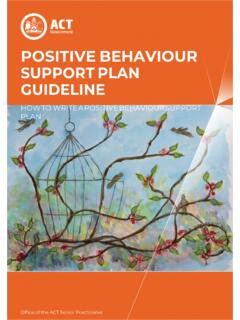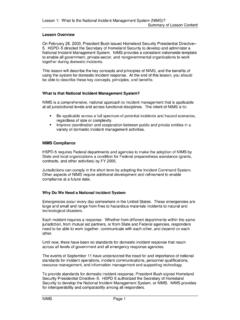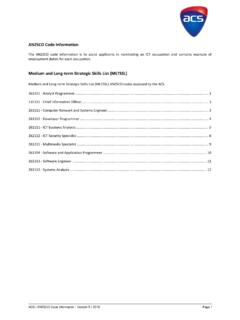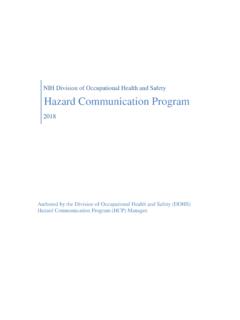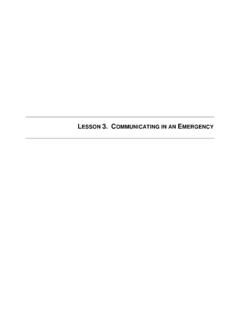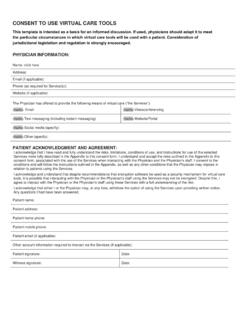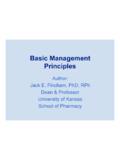Transcription of Person-Centred Emergency Preparedness Planning for COVID …
1 Person-Centred Emergency Preparedness Planning for COVID -19. A GUIDE TO ASSIST YOU TO DEVELOP. YOUR OWN Emergency Preparedness . PLAN FOR COVID -19. WITH THANKS. QUEENSLANDERS WITH DISABILITY NETWORK. nothing about us without us Person-Centred Emergency Preparedness Planning for COVID -19. A GUIDE TO ASSIST YOU TO DEVELOP YOUR OWN. Emergency Preparedness PLAN FOR COVID -19. Authors A/Prof Michelle Villeneuve Centre for Disability Research and Policy, The University of Sydney E: W: Michelle Moss Business Development and Operations Manager, Queenslanders with Disability Network E: W: Louise Abson Project Officer, Queenslanders with Disability Network E: W: Ricky Buchanan Bedridden Disability Advocate E: W: Suggested Citation: Villeneuve, M., Moss, M., Abson, L., & Buchanan, R. (2020). Person- Centred Emergency Preparedness Planning for COVID -19.
2 A resource produced for the Queensland Government Department of Communities, Disability Services and Seniors. Queenslanders with Disability Network and The University of Sydney. This guide was funded by Queensland Department of Communities, Disability Services and Seniors and conducted in partnership with University of Sydney and Queenslanders with Disability Network. Person-Centred Emergency Preparedness Planning for COVID -19. This is a guide to help people with disability to get the facts about Coronavirus ( COVID -19) and make a plan for how they will manage the impact of this situation. People with disability need a plan that is tailored to their unique support needs. Who developed this guide? Queenslanders with Disability Network is working with a team at The University of Sydney who lead research on Disability Inclusive Disaster Risk Reduction.
3 We work together to make sure people with disability are aware and prepared for all emergencies . This resource is funded with support from the Queensland Government Department of Communities, Disability Services and Seniors. We work in partnership with people with disability to make sure they are included in all decisions about Emergency management and disaster risk. We are working together during this public health Emergency because we know that people with disability are at greater risk of contracting COVID -19 and may develop more severe symptoms. The ACT Government would like to acknowledge and thank the Queensland Government, Queenslanders with Disability Network and The University of Sydney for developing this valuable resource. What is in this guide? This guide provides links to trusted sources of information about COVID -19 that have been made available in different formats to help people with disability get the information they need.
4 It includes information about: understanding COVID -19 and how to protect yourself;. making a plan for how you will manage during this public health Emergency ;. knowing what to do if you or someone who supports you experience symptoms of COVID -19. Person-Centred Emergency Preparedness Planning for COVID -19 3. In this guide, we are using the Person-Centred Emergency Preparedness (PCEP) Toolkit (Villeneuve et al., 2019). The PCEP helps people with disability to tailor Emergency Preparedness Planning to their capabilities and function-based support needs. The PCEP. was developed by researchers at The University of Sydney through a co-design process involving people with disability and the services that support them. Why is this guide important? People with disability, their family and carers need the facts about they have the facts, they need to make a plan for how they will act together with their support network.
5 Some people with disability: have trouble getting the facts about emergencies and making a plan because information is not always accessible. need to adapt public health prevention strategies for COVID -19 to their abilities and living situation. Until recently, there were no tools for people with disability to make Emergency Preparedness plans tailored to their support needs. The PCEP (Villeneuve et al., 2019) is an Australian-designed toolkit that helps people with disability to make a plan for how they will act together with their support network during emergencies . The PCEP Toolkit has a series of three videos to show the PCEP. in action. The PCEP Toolkit can be accessed here: org/prepare-nsw/. 4 Person-Centred Emergency Preparedness Planning for COVID -19. What should I do? There are two things you can do now to keep yourself safe: 1.
6 Get the facts about COVID -19 so you understand your risks and can take steps to protect yourself;. 2. Make a plan for how you will manage the risks to your health and well-being during this period of uncertainty. This includes knowing what you will do if you or someone who supports you experience symptoms of COVID -19. We all need to be prepared and know what to do before, during, and after an Emergency . People with disability may need additional support, resources, or advocacy during this health Emergency . Public health emergencies are unpredictable. Novel coronavirus ( COVID -19) is a new virus that has no treatment at this time. This can make people feel worried or anxious. Having a plan means knowing how you will: manage your own needs;. stay in touch with family, friends and workers in different ways to help stop the spread of the virus.
7 Know where to get help; and support others during this period of uncertainty. Having a plan helps: people to manage their mental health and well-being;. build individual and community resilience. Person-Centred Emergency Preparedness Planning for COVID -19 5. Get COVID -19 Facts Let's start with the facts: You might catch novel coronavirus ( COVID -19) if: Someone with the virus sneezes or coughs near you Someone with the virus coughed or sneezed onto a surface (like a door handle) that you touched, and you get infected droplets on your hands and then transfer them to your mouth, nose, or eyes when you touch your face or eat. There are 5 ways that we can all help stop the spread of viruses: 1. Clean your hands regularly with soap and water or alcohol-based hand rubs. 2. Cover your nose and mouth with a tissue or bent elbow when coughing or sneezing.
8 3. Avoid touching your face, nose and mouth. Do not shake hands. 4. Stay home if you are unwell. 5. Practice physical distancing, which includes staying meters away from others as much as you can. m is like two big steps or two arms length. ACT Health also recommend that you get a flu vaccination. Talk to your doctor or pharmacist to see if this is right for you. Household cleaning is also important: Germs can live outside of the body, on surfaces, after a person coughs or sneezes. Regular cleaning is important for: reducing the spread of germs and minimising the number of germs surviving on surfaces. You can use regular cleaners and disinfectant sprays or wipes from the supermarket. 6 Person-Centred Emergency Preparedness Planning for COVID -19. How do I get information about COVID -19? Get the facts from trusted sources. ACT Health Follow ACT Health on Facebook ACTH ealthDirectorate COVID -19 Helpline (02) 6207 7244.
9 Talk to your GP. Australian Government Department of Health National Disability Insurance Agency (NDIA) coronavirus Disability Information Helpline 1800 643 787. Get accessible information: You can find up to date resources in different accessible formats and links to trusted sights here: You can find out more about COVID -19 in accessible formats here: The NDIS has many useful accessible resources about COVID -19 here: Person-Centred Emergency Preparedness Planning for COVID -19 7. Have a conversation: Find people who can help you to get started - this may be your GP, house mates, family or friends. These are the people you should talk with. You do not have to plan alone, and it is important to reach out to others for support. Communication is key. Talk with the people who support you, including your paid staff about how you will keep each other safe from COVID -19.
10 I've had a lot of questions about re-arranging support workers. When thinking about arranging things for maximum safety, I. found it helpful to know that I have to make arrangements that could work for at least 6. months and potentially 18 or more. There's a big difference between a change I can maybe cope with for 2 weeks or 2 months, and a change I can cope with for many months. Knowing I may need to manage these changes to my support services for a long time helped me to make a better plan. Disability Advocate . 8 Person-Centred Emergency Preparedness Planning for COVID -19. Make a Plan What am I Planning for? 1. Plan to stay at home for 2. Plan what you will do if you or a long period of time someone who supports you gets COVID -19 symptoms How do I make a plan? STEP 1. Identify your strengths and support needs The PCEP helps you break down Planning into eight areas: Person-Centred Emergency Preparedness Capability Wheel (Re-printed with permission).


